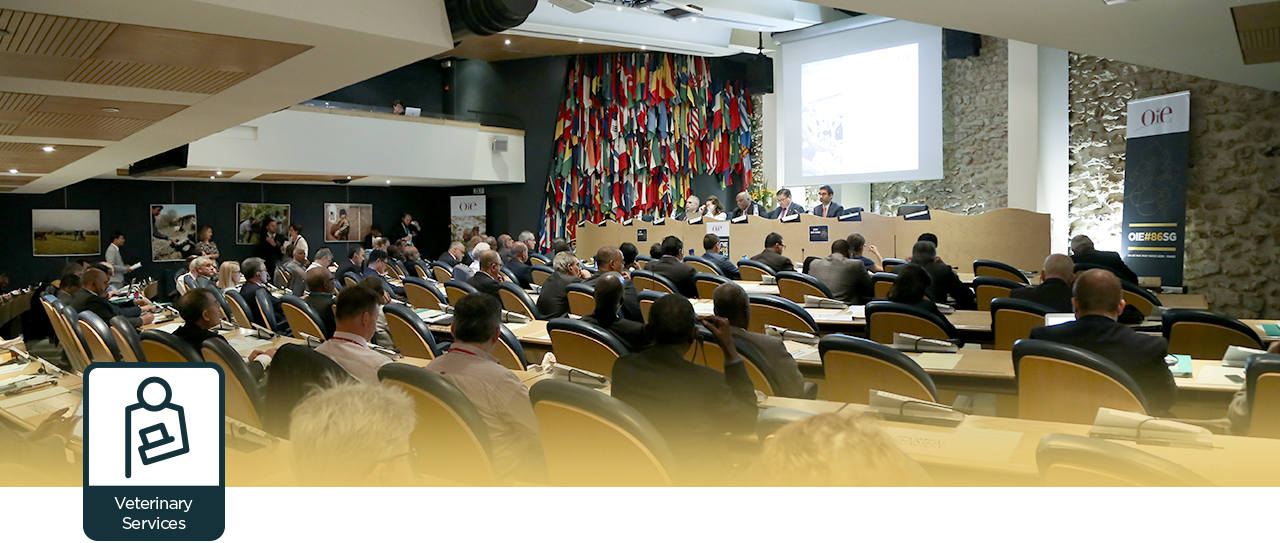Discover dedicated tools designed for you
Misuse and overuse of antimicrobials increase resistance risk,
endangering both animal and human health and welfare.
But YOU can HELP, particularly as a member of the Veterinary Services.
Indeed, you have a role to play infighting antimicrobial resistance.
Animals count on you to encourage your authorities and veterinarians
to implement the OIE international Standards, and globally to ensure that we handle antimicrobials
with care to preserve their efficacy and protect our future.
YOU ARE THE POWERBROKER
Encourage the main communication targets to apply the OIE standards
the new campaign tools
The campaign’s toolkit includes material dedicated to all animal health stakeholders.
These tools highlight the role each stakeholder has to play in ensuring that antimicrobials are used prudently at national level, in line with OIE international Standards that you can consult here:
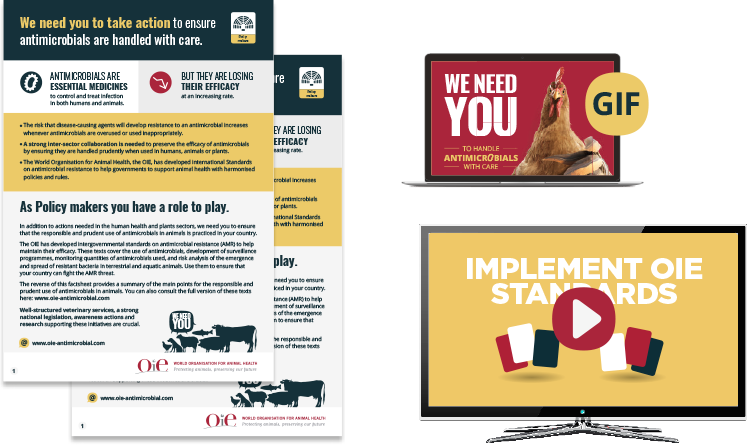 |
Policy makers: the ArchitectsWe need the full involvement and support of policy makers. Their role is to ensure that effective policies are in place from farm to fork – and beyond. Only with the appropriate national legislations in line with OIE international Standards we will be able to build the foundation of a responsible and prudent use of antimicrobials. |
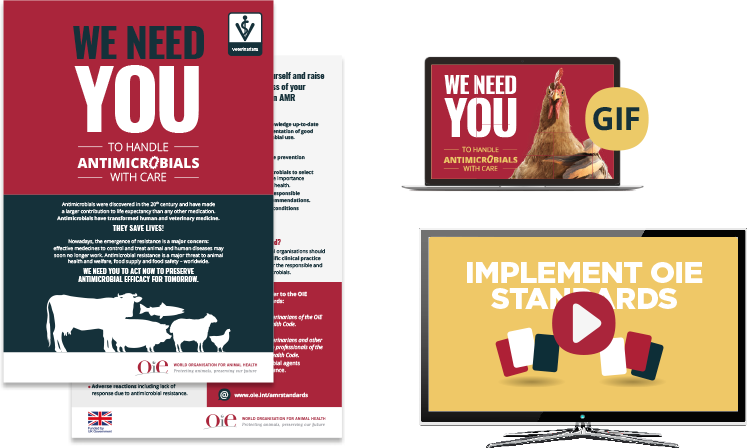 |
Veterinarians: the HeadlinersBeing in contact with both animals and farmers, veterinarians are first on the battle front of antimicrobial resistance. They play a key role in this fight, by ensuring that antimicrobials are only used when necessary and in a prudent way, as well as offering professional advice to farmers and animal owners. They must be fully aware of their role and you can help them understand and apply the rules of responsible and prudent use, in line with OIE international Standards. |
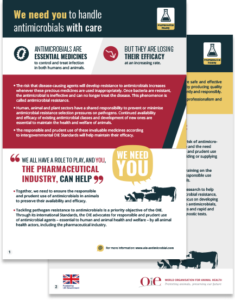 |
Pharmaceutical industry: the GatekeeperBecause the use of approved high quality antimicrobials is crucial in the fight against antimicrobial resistance, the pharmaceutical industry can play an important role in keeping antimicrobials efficient and available for animal health. Research, pharmacovigilance programme and appropriate marketing requirements are all actions pharmaceutical industry can and must do. The pharmaceutical industry’s leadership and influence is central to this fight, demonstrating their professional responsibility and commitment to the sector. |
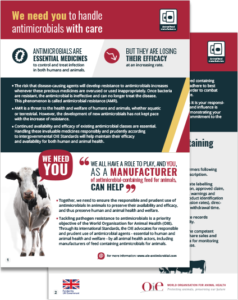 |
Animal feed manufacturers: the IntermediariesFeed manufacturers have a key role in preserving antimicrobial efficacy and availability. By limiting the access of medicated feed to veterinary prescription they can counter overuse and misuse that leads to increase in antimicrobial resistance. For commercial reasons it is sometimes difficult to persuade feed manufacturers on the importance of acting today to protect the future of antimicrobial efficacy. This short document not only aims to inform them about the concrete actions they can put in place but also to sensitize them on the importance of preserving the efficacy of antimicrobials. |
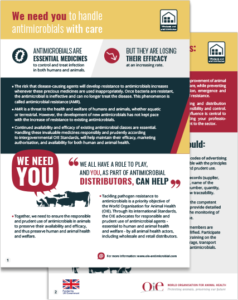 |
Wholesale and retail distributors: the SentinelsBecause distributing drugs such as antimicrobials comes with responsibilities, wholesalers must be aware of the importance of preserving the efficacy and availability of antimicrobials. They must be informed of the importance of distributing only high quality antimicrobials and always on a veterinary prescription. Their professionalism is critical to this fight, demonstrating their professional responsibility and commitment to the sector. |
 |
Farmers: the UsersFood producers and animal owners play a vital role in feeding the planet. They are responsible for providing safe, healthy food to consumers by looking after the health and welfare of their animals. By handling antimicrobials responsibly and prudently according to the OIE international Standards, they will help maintain their efficacy and availability, and thus continue to protect human and animal health and welfare. |
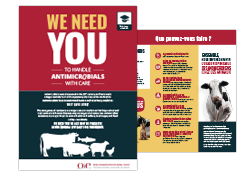 |
Veterinary Students: the FutureVeterinary students are the future. They will be at the frontline in the battle for antimicrobial resistance. In contrast to many of their predecessors, they will be graduating in a time of increased antimicrobial resistance. They need to use their voice to help us preserve the efficacy of antimicrobials, and be aware of what they can do to use antimicrobials responsibly and prudently. |
in your country
These tools are intended to help you, as a member of the Veterinary Services in your country, to implement a successful campaign.
These documents summarise concisely how your target can act to fight antimicrobial resistance. You can send these technical documents by email, post mail, or distribute them in physical meetings.
You can easily identify the document’s target audience through the associated picto
The tools of this OIE international communication campaign are available in English, French and Spanish on: www.oie.int/amrstandards
READY
to run your campaign?

- Understand the messages fully and take ownership of the campaign.
- Discover and carefully read all the tools in the communications package. These can be found in the dossier sent to each country or at the download address.
- Assess your budget and build your project team.
- Adapt the tool to your country (translate if needed).
- Identify and mobilise your partners and suppliers (printing and professional press magazines).
- Print your documents if necessary.
- Organise top-level meetings with your key partners.
- Be aware of everything and every opportunity, you are the project leader!
- Assess the impact of your campaign.
and let us know how successful the campaign was
To estimate the campaign’s outcomes and ultimately guide future campaigns, evaluation is important to assess successes and failures and determine whether the campaign’s objectives were met.
To facilitate this process, we propose using the following indicators:
 |
Number of leaflets, posters and technical brochures sent physically and electronically. |
 |
Number of leaflets, posters and technical brochures printed. |
 |
Number of social media posts. |
 |
Number of meeting and congresses organised. |
 |
Human resources allocated on the AMR campaign. |
 |
Financial Resources allocated to the AMR campaign. |
And you will certainly have more qualitative feedback on campaign perceptions from your collaborators or targets.
Remember to choose and define your indicators at the start of the campaign! Otherwise, you might fail in collecting the necessary data during the campaign for eventual evaluation.

